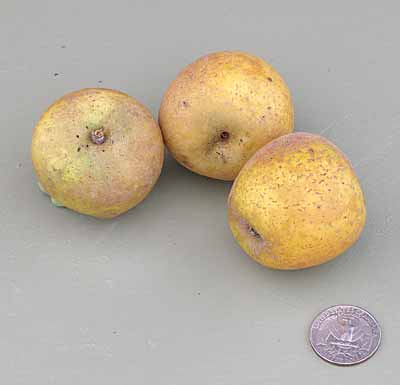
Brandy is a spirit distilled from wine, the best known being Cognac and Armagnac. It derives from brandwine, brandewijn (Dutch), meaning ‘burnt’ or ‘distilled wine’. This also describes a number of liqueurs distilled from fruit juices, such as apple brandy or Calvados, apricot brandy and so on. Once brandy is in the bottle, nothing more happens to it. Any activity occurs in the barrel or cask. Cognac should specifically be from the Cognac region of France, but many languages use words which sound like Cognac phonetically for even their own domestic brandy. Other brandies include Kirsch, Grappa, and Eau de Vie, to name a few. While all brandies are distilled from a mash of fruit, some use only the juice of the fruit, while others include the stones, seed, and skins in addition to the juice. Peru's famous Pisco is an example of a brandy distilled from both the juice and must of the fruit, in this case, grapes

A name for Golden Harvey, a very old variety of flushed blushed and striped, russeted, golden eating apple which probably arose in the 17th Century in Herefordshire and used for making cider because it has a lot of juice. This late-season variety is harvested from mid-October in South-East England is stored and is at its best from December to March.
Butter creamed with sugar and brandy and cooled. It is traditionally served with Christmas pudding, melting in amongst the hot suet and fruit.
A cocktail made with brandy, pineapple syrup, curaçao and maraschino liqueur, garnished with a slice of orange and a cherry.
A cocktail made with brandy, lemon juice, maraschino or orange curacao liqueur, Angostura bitters and sugar, served in a wine glass.
A cocktail made with brandy, lemon juice, soda water, Pernod or maraschino liqueur, grenadine and sugar, served in a wine glass.
A cocktail made with brandy, cream, egg and sugar syrup, served in a wine glass and sprinkled with grated nutmeg.